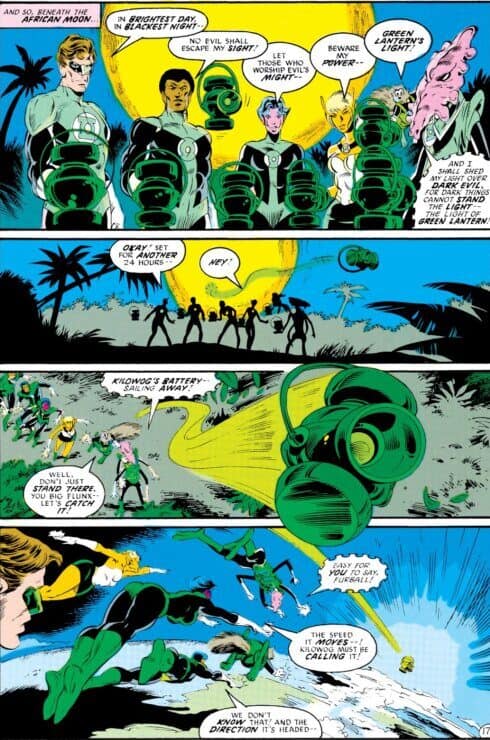***Contains Spoilers***
The Green Lantern Corps (1986-1988) issues #201-224 pick up after the dissolution of the Guardians and set the stage for a bold, albeit uneven, new direction. The series focuses on a seven-member Corps based on Earth, grappling with the loss of traditional Guardians-led structure and the challenges of managing their vastly different personalities and ideologies. Guy Gardner’s unpredictable antics, John Stewart’s ascension as a leader, and Kilowog’s controversial embrace of Soviet communism drive much of the drama. The series culminates in the Corps’ disbandment, leaving behind a foundation of character dynamics but little in the way of a cohesive or gripping narrative.
There are certainly standout elements within these issues. John Stewart’s development as a leader is a highlight. He confidently steps into his role, showing how different his approach is compared to Hal Jordan’s, particularly in how he openly reveals his identity as Green Lantern to the public. This felt fresh and modern, reflecting John’s belief in transparency and responsibility. His romance with Katma Tui also brings heart to the series, making her eventual fate (outside the series) even more tragic in retrospect. Their wedding, surrounded by the larger Corps, is one of the most heartfelt moments in the run.
I liked Kilowog’s storyline, where he moves to Russia and aligns himself with communism. It makes perfect sense that an alien like Kilowog, coming from a highly structured and collectivist society, would find communist ideals appealing. This storyline adds depth to his character and provides a unique perspective on Cold War politics. It’s one of the more thought-provoking parts of the series and feels relevant even today.
Hal Jordan’s interactions, especially his visit to a crippled and mentally unstable Guy Gardner, add a level of emotional weight to the series. Hal’s struggles with his own choices—quitting the Corps, his complicated relationship with Carol Ferris (and her transformation into Star Sapphire)—give him a level of humanity that keeps him relatable, even as the focus shifts to other members of the Corps.

Despite these strong character moments, the series often feels disjointed and lacking focus. While always a wildcard, Guy Gardner is almost unbearable here, unlike his time in JLE. His reckless training on Maltus, escape back to Earth, and constant clashes with other Lanterns are exhausting rather than entertaining. His storyline often felt like filler, with little meaningful growth or payoff. Even when the rogue Guardians resurrect him and give him a ring, his subsequent actions—leading a group of villains on a destructive mission—feel chaotic and poorly paced.
The dissolution of the Corps and the decision to eliminate the sectors after Crisis on Infinite Earths is another weak point. While the idea of the Corps being stationed on Earth was intriguing, it never felt fully realized. By the time the Guardians return and decide to dismantle everything, it feels less like a logical progression and more like a rushed conclusion. The series struggles to find its footing, torn between character-driven drama and the need to tie into larger DC events.
The conclusion to the Green Lantern Corps run is a mixed bag, offering intriguing character development and moments of emotional depth but struggling with pacing and narrative cohesion. John Stewart and Katma Tui are the emotional core, while Kilowog’s storyline provides a unique perspective on the Corps’ interaction with Earth’s politics. Unfortunately, the series is bogged down by Guy Gardner’s over-the-top antics and a lack of direction for the team as a whole. It’s worth reading for the historical context and foundational character work, but as a standalone series, it falls short. I’d give it two stars—fine for completists, but not something I’d revisit.
Feature Image Green Lantern Corps vol.2 #201 Cover Art By Joe Staton
Keep NewToComics.com running with a donation or shopping with through our affiliates—your support helps maintain the site and continue guiding new readers into the world of comics!


